
Assam: Groundbreaking Primate Survey Launched in Dehing Patkai National Park
Guwahati, 2nd May: In a pioneering effort, the Primate Research Centre NE India / Conservation Himalayas, in collaboration with SACON and the Assam Forest Department, has embarked on a comprehensive field survey to assess the population of non-human primate species, with a keen focus on the revered western Hoolock gibbon and Bengal Slow Loris, within the pristine expanse of Dehing Patkai National Park. Commencing in April 2024 and slated to continue until May 2024, this survey represents the inaugural systematic endeavor to cover the entire terrain of the newly designated National Park, where the Hoolock gibbon stands as the emblematic flagship species.
Under the leadership of Dr. Jihosuo Biswas, Sr. Scientist at the Primate Research Centre NE India/Conservation Himalayas, and Dr. HN Kumara, Principal Scientist at SACON, the survey endeavors to elucidate the population status and demographic intricacies of Hoolock gibbons and other primate species inhabiting Dehing Patkai National Park. Additionally, the study aims to evaluate the prevailing habitat conditions for these primate species, thereby facilitating the formulation of an effective management plan in collaboration with the forest department.
To equip personnel with the requisite expertise, a comprehensive Census Technique Workshop convened on April 23, 2024, at Joypur Forest IB. A cohort comprising 10 enumerators from PRCNE/CH and SACON, alongside 26 forest personnel, underwent rigorous training on primate census estimation techniques. The workshop, inaugurated by Divisional Forest Officer Sandeep Bantale, witnessed insightful guidance from Dr. Jihosuo Biswas and Dr. Jayanta Das of Wildlife Areas Development and Welfare Trust (WADWT), Guwahati, on various census methodologies, including line transect, occupancy, and call count methods.
Following theoretical sessions, practical field training ensued within the park premises, enabling trainees to adeptly navigate diverse field techniques, encompassing GPS operation, map utilization, compass bearing for call counts, and primate age-sex identification. A reliability test, or reconnaissance survey, conducted during training, preempted potential biases in the ensuing survey.
Officially launched on April 24th, 2024, from the Jaypur Range of Dibrugarh Division, the survey adopts a block count framework integrating the occupancy and call count methods. By subdividing counting blocks into discrete units overlaid with 50-hectare grid cells, the survey aims to delineate the spatial distribution of Hoolock gibbons and other primate species within the park through occupancy modeling.
Eight enumeration parties, comprising 3-4 individuals each, supplemented by local villagers and forest personnel, spearhead the survey across designated counting blocks. Armed with essential equipment, including maps, GPS devices, android mobile phones, binoculars, cameras, and wireless handsets, these teams navigate the park’s terrain, marking the inaugural utilization of the occupancy method alongside the call count method within Dehing Patkai National Park, as affirmed by Dr. Biswas.
Read More: Assam: Heavy Rainfall Triggers Severe Flooding in Dima Hasao; communication disrupted
